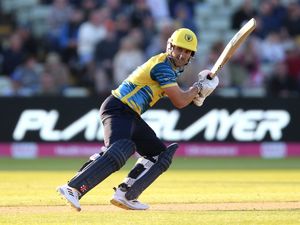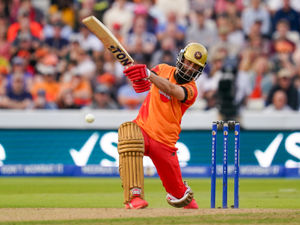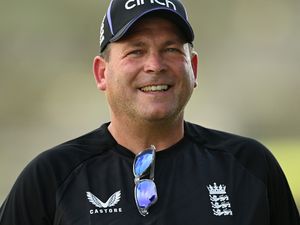Matt Maher: Brian Lara pulls curtain back on summer of '94
Brian Lara has written a book. It only took him two months.
By his previous standards, that is slow.
“Back in 1994, I spent three days in an apartment on Hagley Road with a journalist and we produced a book,” the West Indies and Warwickshire legend explains.
Lara refers unashamedly to the earlier work as a “money book”, produced at lightning speed to capitalise on his sudden fame, after one of the most extraordinary runs of form seen in any sport.
Three decades on, at the age of 55, this new effort is an attempt at reflection and making sense, not just of that period but a career the like of which few could ever dream but which Lara – for reasons to be explained later – says fell short of his own aspirations.
“You know all my numbers. You know all my innings. You don’t need to hear about all that again,” he told an audience of Warwickshire members this week. “You need to know how I felt, about my career and what I was going through, day-in, day-out.”
Lara might not consider the numbers too relevant. But for those with even the merest interest in cricket and for the purposes of context, they will always be worth examining. All these years on, they remain head-spinning. In the space of 50 days in the spring and early summer, Lara broke two world records. The first, on April 18, saw him surpass Sir Garfield Sobers’ 36-year-old mark for the highest ever score in a Test match, when he scored 375 against England in Antigua.
Then, on June 6 while playing in the County Championship for Warwickshire, Lara set a new record for the highest score in any first-class match, hitting an unbeaten 501 against Durham, beating the previous best of 499, set by Hanif Mohammed in 1959.
In between, Lara scored five centuries in his first six matches for the Bears. A hugely impressive achievement in itself, it seems almost modest in comparison.
There would be plenty more personal highs to follow, in a career which ended with him having compiled nearly 12,000 Test match runs and reclaimed the record for highest Test match score (with 400 not out against England) barely a month after Matthew Hayden had taken it off him in 2004.
Yet it is those seven or so weeks in 1994, from Antigua to Edgbaston, which guaranteed his legend and created a brand the like of which cricket had never seen before. In almost the blink of an eye, Lara went from a promising yet relatively unknown West Indies batter to the sport’s first global superstar, who would later have his own logo and his name associated with a best-selling video game.
“The thing with Brian, is it all happened so fast,” remarks former West Indies team-mate Jimmy Adams in the book’s foreword.
The speed of the transformation presented the biggest challenge. From being a guy who could walk down any street without being hassled, Lara suddenly possessed one of the most recognisable faces in the world. In 1994, it is claimed he was photographed more than Princess Diana. Even now, it is difficult to determine just how much he enjoyed the experience.
“I was really happy I came through it,” says Lara, who while remaining in the form of his life as the Bears went on to claim three trophies, was quickly beginning to feel the strain away from the pitch.
“It got to the point where I had no time for myself,” he writes. “My life was not my own.”
There are regrets, at some of his behaviour. There is admirable honesty too, with an infamous picture of Lara answering a mobile phone while fielding at slip (he would be criticised in the press for not taking the match seriously) is revealed to have been nothing more than a misguided dressing room prank.
Viewed from the modern era, when the risks of burnout are talked about far more, the flaws are far more understandable.
“He had so little support,” says Paul Smith, Lara’s friend and former Bears team-mate. “No matter how much support the club gave him, it was not enough.
“In this day and age he would have a mountain of people around him protecting him from the kind of intrusion he faced. At the time, that was never going to happen. We did what we could.”
Warwickshire, in their defence, could never have been prepared for the level of fame Lara acquired. At that time, few sports clubs on the planet could.
It had needed a huge twist of fate to bring Lara to Edgbaston in the first place. Signed when Pakistan batter Manor Prabhakar, the club’s original overseas player for that summer, suffered injury, Warwickshire chief Dennis Amiss had negotiated a contract worth just £40,000. Then came Antigua and the 375.
“If we had waited a few weeks, I might have got a lot more!” laughs Lara now. “It was probably the best £40,000 Warwickshire ever spent and definitely the best £40,000 I ever received.
“My best friend, Dwight Yorke, was in Birmingham and most importantly I got to play county cricket. It was an amazing experience.”
Back then, the County Championship was considered the most testing proving ground outside the Test arena. Still, you might expect someone who had just recorded a record score in the latter to arrive with a good deal of confidence? Not in the slightest.
“I was very scared about how things would go in England. That is the honest truth,” says Lara. “OK, I had broken a world record but what was my record in England? I played nine or 10 first-class games on the West Indies tour in 1991 and averaged 28.
“You have to understand there was this big expectation, this frenzy which was following me that was expecting me to take the game to every attack. I was very scared.”
The manner in which Lara, who played his first match for Warwickshire just eight days after the 375, was able to quickly adapt his style from the hard, fast pitches of his homeland to the green seamers of England might just be the most impressive aspect of the whole story.
“The fact I came out and performed from game one, it meant I refreshed my thinking.” he says. “I had to understand the conditions quickly. And I did. That is something I am truly proud of.”
While Lara looks back on ‘94 with a level of satisfaction, the same cannot be said of his entire career. Just as destiny, he believes, put him in the right place at the right time to reach those records, so he was unfortunate to enter the game at the point the West Indies’ era of dominance was ending.
The finest player of his generation, who had three spells captaining the national team, the burden to continue the success weighed heavy. He can still feel it.
“It’s quite simple,” says Lara. “You don’t start your career in a team sport thinking about individual goals. You start your career thinking about how much you can keep your team at the top of the tree. I just couldn’t. That is the disappointment of my career.”
For Lara, as he writes in the book: “Cricket is an expression of collective action, or nothing at all.”
That is one way of seeing it. Another is individual achievements really do mean something, no matter the outcome.
Lara’s 375 and 501 not out both came in drawn matches, yet still they provoked awe and wonder. Still, they are celebrated. These were not just Lara’s moments but of all who shared them, who watched them, who fell in love with cricket through watching them.
Lara, as he has come to realise, had it right in 2007, walking off the field for the final time as a player following West Indies’ World Cup defeat to England.
“All I ask is, did I entertain? If I entertained you, I’m happy.”
He entertained, alright. He should be very happy.
n Lara: The England Chronicles, published by Fairfield Books, is out now.




